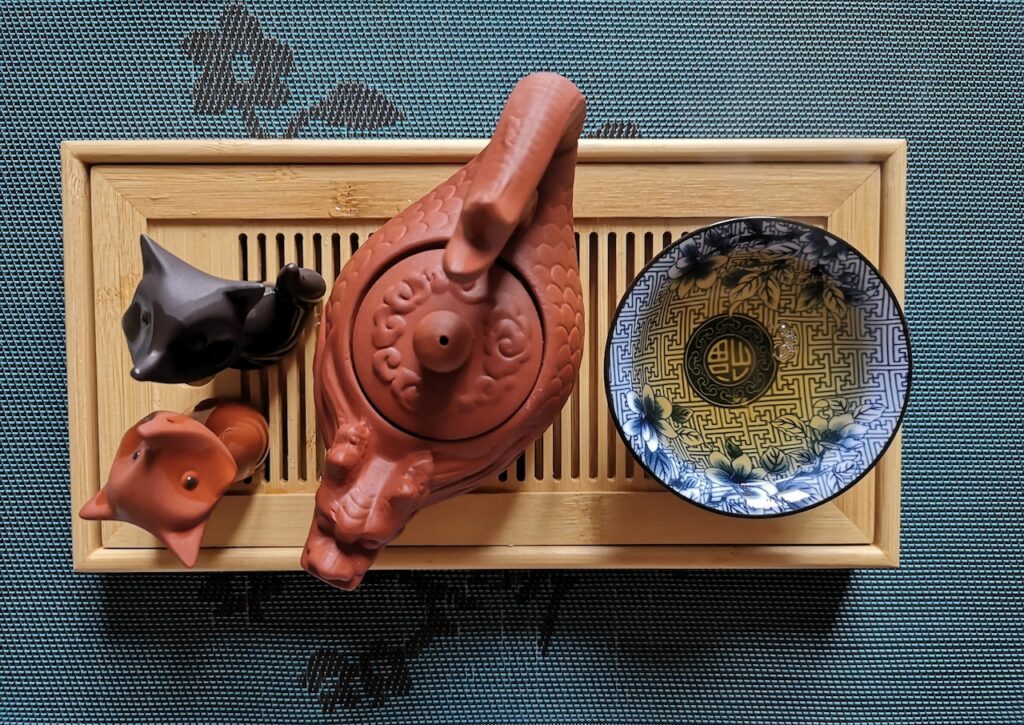Queste teiere in argilla derivano proprio da quest’area della Cina da cui prendono il nome Yixing. La loro particolarità è che trattengono l’aroma del tè e dopo diverse infusioni il tè bevuto è ancora migliore. Per questo motivo come tutte le teiere, ma a maggior ragione queste, vanno pulite semplicemente con acqua e andrebbero utilizzate soltanto per una tipologia di infuso. Queste teiere sono perfette per gli oolong, gli affumicati e i fermentati come i puerh.
Oggi le teiere Yixing sono prodotte in serie, ma in antichità erano prodotti unici fatti a mano e più venivano utilizzate più diventavano pregiate e acquisivano valore. Questo genere di teiera è adatta alle infusioni multiple dove le foglie vengono infuse a intervalli da 30 secondi a 1 minuto fino a 10 volte e anche oltre a seconda della tipologia del tè utilizzato. Prima di ogni infusione teiera e tazzine vengono sempre lavate e scaldate con acqua calda che poi viene gettata. Al contrario delle kyusu giapponesi non sono dotate di filtro ma la bocca della teiera è appositamente stretta per non fare passare le foglie e filtrare bene l’infuso.
Il rito del tè in Cina noto come Gong fu cha significa “preparare il tè con cura e attenzione e grande abilità” e può essere utilizzato con tutte le tipologie di tè cinesi. Questa tipologia di rito è una forma per mostrare agli ospiti rispetto, altruismo e ringraziamento. In Cina si dice che sia scortese non offrire una tazza di tè ai propri ospiti.
Il set da tè per questo particolare rituale consiste in un vassoio di legno detto “cha-pan” che servirà per fare colare l’acqua in eccesso, che verrà versata su teiera e tazzine per pulirle e scaldarle prima di procedere alla vera e propria infusione delle foglie.
E’ fondamentale essere dotati di un tovagliolo pulito per asciugare le eventuali perdite, perché nel rito del tè è importante che la zona in cui si serve il tè sia sempre ordinata.
Il set comprende teiera, piattino per le foglie “cha he”, pinze in bambù dette “cha jia”, cucchiaio dosatore “cha ze”, tazze per gli ospiti, un bricco “cha hai” e un bicchiere per il “liquore” che servirà per degustare l’aroma del tè.
Durante questa cerimonia si ammira il colore e la nitidezza del tè prima di degustarne il sapore. Così come il primo atto è quello di annusare l’aroma da dove ha inizio il vero e proprio viaggio sensoriale.
Questa tipologia di set è adatto per i tè in foglie a più infusione.
Prima di tutto teiera e tazze vengono lavate con acqua calda poi viene presentato il tè in foglie, che verrà a sua volta pulito con acqua. Si elimina l’acqua con cui si è effettuata la pulizia e poi si passa alla preparazione e alla degustazione del tè vera e propria.
Nel rito cinese tradizionale sul vassoio troviamo delle piccole statue in terracotta dette animaletti del tè o “cha chong”. Si dice che la scelta dell’animaletto del tè rappresenti l’anima e che i poteri dell’animale vengano trasferiti alla persona che beve il tè.

Rito cinese del tè detto Gong Fu Cha – Photo@Veru
Ritual with Yixing Teapot

These clay teapots derive from this area of China from which they take the name Yixing. Their peculiarity is that they retain the aroma of the tea and after several infusions the tea drunk is even better. For this reason, like all teapots, but even more so these, should be cleaned simply with water and should be used only for one type of infusion. These teapots are perfect for oolong, smoked and fermented like puerh.
Today Yixing teapots are produced in series, but in ancient times they were unique handmade products and the more they were used the more they became valuable and acquired value. This kind of teapot is suitable for multiple infusions where the leaves are infused at intervals from 30 seconds to 1 minute up to 10 times and even more depending on the type of tea used. Before each infusion, the teapot and cups are always washed and heated with hot water which is then thrown away. Unlike the Japanese kyusu they are not equipped with a filter but the mouth of the teapot is specially narrow to prevent the leaves from passing and to filter the infusion well.
The tea ritual in China known as Gong fu cha means “making tea with care and attention and great skill” and can be used with all types of Chinese tea. This type of ritual is a way to show guests respect, altruism and thanks. In China it is said that it is rude not to offer a cup of tea to one’s guests.
The tea set for this particular ritual consists of a wooden tray called “cha-pan” which will be used to drain the excess water, which will be poured onto the teapot and cups to clean and heat them before proceeding to the actual infusion of the leaves.
It is essential to be equipped with a clean napkin to wipe away any leaks, because in the tea ritual it is important that the area where the tea is served is always tidy.
The set includes teapot, saucer for “cha he” leaves, bamboo tongs called “cha jia”, “cha ze” measuring spoon, cups for guests, a “cha hai” jug and a glass for the “liquor” that it will be used to taste the aroma of the tea.
During this ceremony you can admire the color and clarity of the tea before tasting its flavor. Just as the first act is to smell the aroma from where the real sensory journey begins.
This type of set is suitable for multi-infused loose leaf teas.
First of all, the teapot and cups are washed with hot water, then the tea leaves are presented, which will in turn be cleaned with water. The water with which the cleaning was carried out is eliminated and then proceeds to the preparation and tasting of the actual tea.
In the traditional Chinese rite on the tray we find small terracotta statues called tea animals or “cha chong”. It is said that the choice of the tea animal represents the soul and that the animal’s powers are transferred to the person who drinks the tea.



No responses yet